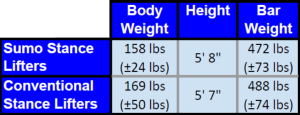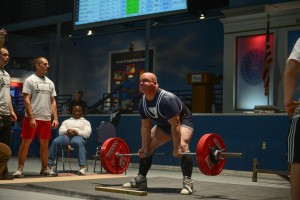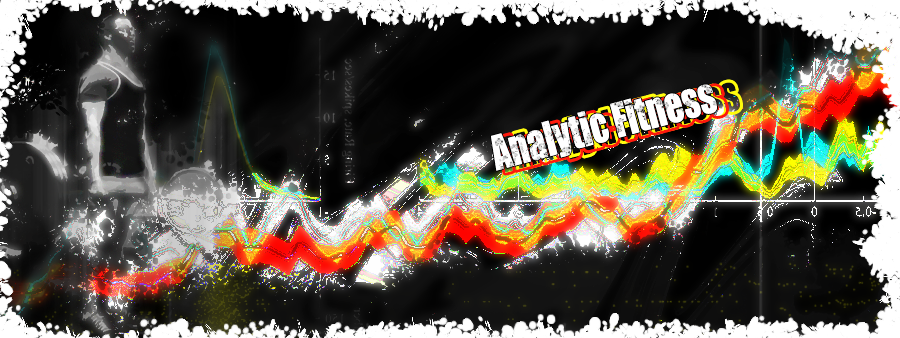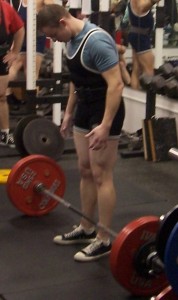A look at my favorite lift
From time to time, I will look at studies that examined various exercises and activities. Today, I want look at a study of the deadlift. Full disclosure: The deadlift is literally my favorite lift to do. Don’t mind me as I geek out here.
There are many ways that researchers can approach the examination of an exercise. The researchers of this study chose to examine the different mechanics of two deadlift stances. In later posts, I’ll look at studies that examined other aspects of the deadlift. I’ve enjoyed today’s paper ever since I first read it years ago. This study was done by Escamilla, et al. in 2000. The title is, A three-dimensional and biomechanical analysis of sumo and conventional style deadlifts.
Methods
The researchers studied 24 masters’ level male powerlifters who all competed in a national championship. As masters’ level lifters, all of the participants were also at least 40 years old. Given the weights used and that they competed, I think we can call these trained lifters, in the research sense. Since I care about the descriptive info of participants in these studies, you can count on me to share them. The averages are in the chart below.

Escamilla, et al. 2000 Descriptive Data
Half performed the deadlift with the conventional stance and half performed the deadlift with the sumo stance. Remember that the conventional stance has the lifter generally stand with his/her legs straight down to the bar. Below is a picture of me from a meet in 2009. I used the conventional stance.
The sumo stance is basically like the name implies, with the lifter taking that squat, sumo wrestler kinda stance at the bar. This is the stance that I use these days. Unfortunately, I don’t have a picture of myself using it. Below is a picture of another lifter using the sumo stance.

Sumo Stance Deadlift
In both cases, once a lifter has taken the chosen stance at the bar, s/he reaches down, grabs the bar, and “pulls” the weight up until standing straight. Without question, nuances abound with the execution of the deadlift. But you get the idea. In this study, each lifter had 3 chances to attempt their near-1RM weight, with each attempt reviewed by 3 judges for completion.
The researchers recorded the lifts with 2 synchronized cameras, which provided the data to generate 3D models of each lift for analysis.
Results
In a nutshell, the conventional stance deadlift style requires more work.
The conventional stance requires more work. Let’s not kid ourselves. Though, when we work with 1RM kinda weights, it’s all hard. I’m not trying to imply that one of the styles is better than the other when I say one requires more work than the other.
As expected, the foot position in the sumo stance was twice as wide as the foot position of the conventional stance. That resulted in a lower center of mass for users of the sumo stance. In the case of this study, the sumo stance lifters had 20-25% less distance to pull the barbell to lockout. That resulted in 25-30% less mechanical work to complete the sumo stance deadlift. Interestingly, though, the average time the lifters took to complete the lift was only different by 0.4 seconds.
A few other differences between the stances were:
- Lifters that used the sumo stance had a more upright torso during the movement
- Both stances had the same hip dynamics
- The sumo stance dynamics implied more use of the quads, while the conventional stance dynamics implied more use of the hamstrings
- For 75% of lifters, the quickest part of the pull was before the bar got to their knees
- The “sticking point”, also known as the hard part of a lift, was just past the knees
- The sumo stance dynamics implied that sumo may be slightly more safe for the lower back, while the conventional stance dynamics implied that conventional may be better for strengthening the back and hamstrings
Calorie Counting
Before I wrap this up, I want to note a part of this study that I liked as soon as I read it. The researchers took the time to calculate the expected energy expenditure of deadlifting, based on the merger of their data with previously published data. They used the setup of 80% of a 1RM weight (484 lbs) for 4 sets of 8 repetitions. That’s reasonable, as 4×8 is a fairly common setup. In just the time spent to do the reps, the sumo stance should burn 91 calories and the conventional stance should burn 111 calories. When the researchers factored in the calories burned during the recovery of the sets, the researchers calculated a range of 14-17 calories burned per minute from deadlifting. Mind you, this involved 70% of the time sitting around resting between sets. Put another way, that kind of calorie burn relative to walking or jogging is high.
Implications / Thoughts
As many who have worked with the deadlift know, each stance brings its own challenges and effects to the table. The primary point to note for any non-competitive lifter, I think, is that the stances are still very similar overall. While the conventional stance may require more work to complete the lift, work is still required to complete the sumo stance deadlift. Whichever style a lifter can use, due to knowledge or injury or mobility, the important point is that deadlifting is a single exercise that will work his/her whole body. It’s effective and efficient, including on the calorie burning level.
In Conclusion
Deadlifting is one great way to develop overall strength. There are even more ways to vary the lift than just these two stances. Lifters have plenty of options to find what works for them and to get to know the details of that style. As lifters develop their strength, they will also have the benefit of burning more calories during the exercise while while sitting around resting afterward.
If you have any questions about this study or anything I said, please feel free to leave a comment. I will get back to you and others may have insight to offer, too. If you have any questions or topic suggestions that you would like answered as a post, then please email me at robert@analyticfitness.com.
Don’t forget to like Analytic Fitness on Facebook, or follow me on Twitter or the other social medias!






It’s interesting that you can have two types of stances for lifts, which in itself says that they have different results. The more interesting part is where there is variation in technique within each stance which determines what works best for each individual. One person can get something different from another person just based on a tweak in technique.